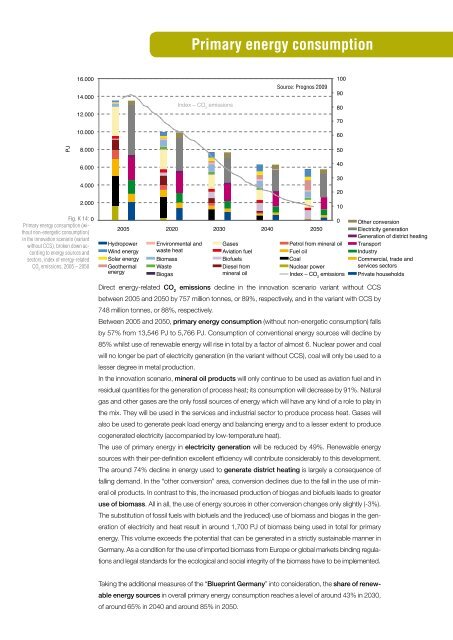Blueprint Germany - Öko-Institut eV
Blueprint Germany - Öko-Institut eV
Blueprint Germany - Öko-Institut eV
You also want an ePaper? Increase the reach of your titles
YUMPU automatically turns print PDFs into web optimized ePapers that Google loves.
PJ<br />
16.000<br />
14.000<br />
12.000<br />
10.000<br />
8.000<br />
6.000<br />
4.000<br />
2.000<br />
Fig. K 14: 0<br />
Primary energy consumption (without<br />
non-energetic consumption)<br />
in the innovation scenario (variant<br />
without CCS), broken down according<br />
to energy sources and<br />
sectors, index of energy-related<br />
CO emissions, 2005 – 2050<br />
2<br />
Primary energy consumption<br />
Index – CO 2 emissions<br />
Source: Prognos 2009<br />
0<br />
Other conversion<br />
1985 1986 2005 1987 1988 1989 2020 1990 1991 1992 2030 1993 1994 1995 2040 1996 1997 1998 2050 1999 2000 2001 Electricity generation<br />
Generation of district heating<br />
Hydropower Environmental and Gases Petrol from mineral oil Transport<br />
Wind energy waste heat<br />
Aviation fuel Fuel oil<br />
Industry<br />
Solar energy Biomass<br />
Biofuels Coal<br />
Commercial, trade and<br />
Geothermal<br />
energy<br />
Waste<br />
Biogas<br />
Diesel from<br />
mineral oil<br />
Nuclear power<br />
Index – CO emissions<br />
2<br />
services sectors<br />
Private households<br />
Direct energy-related CO 2 emissions decline in the innovation scenario variant without CCS<br />
between 2005 and 2050 by 757 million tonnes, or 89%, respectively, and in the variant with CCS by<br />
748 million tonnes, or 88%, respectively.<br />
Between 2005 and 2050, primary energy consumption (without non-energetic consumption) falls<br />
by 57% from 13,546 PJ to 5,766 PJ. Consumption of conventional energy sources will decline by<br />
85% whilst use of renewable energy will rise in total by a factor of almost 6. Nuclear power and coal<br />
will no longer be part of electricity generation (in the variant without CCS), coal will only be used to a<br />
lesser degree in metal production.<br />
In the innovation scenario, mineral oil products will only continue to be used as aviation fuel and in<br />
residual quantities for the generation of process heat; its consumption will decrease by 91%. Natural<br />
gas and other gases are the only fossil sources of energy which will have any kind of a role to play in<br />
the mix. They will be used in the services and industrial sector to produce process heat. Gases will<br />
also be used to generate peak load energy and balancing energy and to a lesser extent to produce<br />
cogenerated electricity (accompanied by low-temperature heat).<br />
The use of primary energy in electricity generation will be reduced by 49%. Renewable energy<br />
sources with their per-definition excellent efficiency will contribute considerably to this development.<br />
The around 74% decline in energy used to generate district heating is largely a consequence of<br />
falling demand. In the “other conversion” area, conversion declines due to the fall in the use of mineral<br />
oil products. In contrast to this, the increased production of biogas and biofuels leads to greater<br />
use of biomass. All in all, the use of energy sources in other conversion changes only slightly (-3%).<br />
The substitution of fossil fuels with biofuels and the (reduced) use of biomass and biogas in the generation<br />
of electricity and heat result in around 1,700 PJ of biomass being used in total for primary<br />
energy. This volume exceeds the potential that can be generated in a strictly sustainable manner in<br />
<strong>Germany</strong>. As a condition for the use of imported biomass from Europe or global markets binding regulations<br />
and legal standards for the ecological and social integrity of the biomass have to be implemented.<br />
Taking the additional measures of the “<strong>Blueprint</strong> <strong>Germany</strong>” into consideration, the share of renew-<br />
able energy sources in overall primary energy consumption reaches a level of around 43% in 2030,<br />
of around 65% in 2040 and around 85% in 2050.<br />
100<br />
90<br />
80<br />
70<br />
60<br />
50<br />
40<br />
30<br />
20<br />
10

















